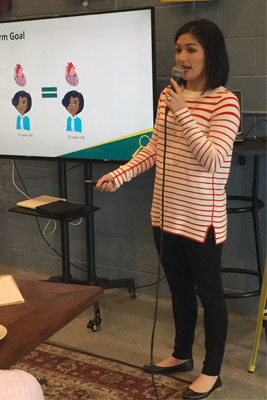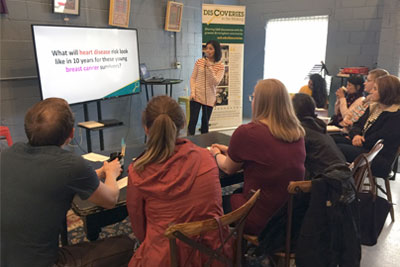You are at a dental clinic because of a terrible toothache. After examination, your dentist gives you two choices – extracting all the teeth that are causing pain or taking temporary pain killers. You are also warned about the impossibility of getting dentures if you pick the former.
“Pain relief” being your number one priority, the former would be your obvious choice, in spite of knowing the chewing difficulties the extraction might cause you in the long run.
 Patients diagnosed with breast cancer, unfortunately, face similar and a more intense dilemmatic situation. Because of the pressure of having a life-threatening disease, the majority of patients most likely agree to undergo breast cancer treatment, despite the possibility of potential cardiovascular risks the cancer treatment might pose.
Patients diagnosed with breast cancer, unfortunately, face similar and a more intense dilemmatic situation. Because of the pressure of having a life-threatening disease, the majority of patients most likely agree to undergo breast cancer treatment, despite the possibility of potential cardiovascular risks the cancer treatment might pose.
UAB doctoral student Jacqueline Vo’s interest in cardio-oncology (the intersection of heart conditions in patients who have been treated for cancer) has led her to look at treatment toxicities and, in turn, the link between breast cancer and heart disease.
Having been involved in breast cancer research because of her mentor, Dr. Karen Meneses, and with her clinical experience in caring for patients after open-heart surgery, Vo was driven to study the risk factors leading to heart disease and breast cancer.
“A lot of risk factors that lead to heart disease are the same for breast cancer as well,” said Vo, a former nurse at UAB’s Cardiothoracic Intensive Care unit. “Someone who is diagnosed with breast cancer may already have some of the risk factors for heart disease. So, that in combination with treatment toxicities can lead to early heart disease.”
Why heart disease follows breast cancer?
Risk factors like obesity, poor diet and physical inactivity are similar for both breast cancer and heart disease. Treatment factors like chemotherapy, radiation or hormone therapy can increase the risk of heart disease in breast cancer survivors.
With respect to treatment toxicities, Vo is particularly interested in studying Doxorubicin – an anti-cancer drug used in chemotherapy – since it can increase the risk of developing heart failure. Known to survivors as the “Red Devil,” it may cause heart failure during, or a few years after, treatment.
“Doxorubicin introduces cardiomyopathy – chronic disease of the heart muscle – by inflaming and killing the cardiac cells leading to having a large heart,” Vo said.
Having a large heart thereby reduces its ability to pump blood with normal efficiency, leading to a congestive heart failure.
A heart-breaking story urging the need for a change
A 37-year old breast cancer survivor, who was diagnosed with the disease at 35 and underwent treatment, visited Vo to learn more about her research. The survivor shared with Vo that she was finding it difficult to walk even 10 feet without having shortness of breath. What was more devastating to Vo was the inability of the survivor to keep up with her own active toddler’s pace while the little one ran around. The survivor had been diagnosed with heart failure, and she wanted to learn more from Vo about the link between breast cancer and heart disease.
Patients like this survivor and many other heart-rending stories keep propelling Vo to find solutions and provide them with a better quality of life.
Vo’s Research
 Vo analyzed medical records of breast cancer patients who were diagnosed prior to 45 years of age. To know their risk of developing heart disease, she studied them at breast cancer diagnosis and after treatment completion. In addition, she calculated the patients’ “heart age” during the two periods.
Vo analyzed medical records of breast cancer patients who were diagnosed prior to 45 years of age. To know their risk of developing heart disease, she studied them at breast cancer diagnosis and after treatment completion. In addition, she calculated the patients’ “heart age” during the two periods.
Heart age estimates the 10-year risk of heart disease using several factors, including age, systolic blood pressure, smoking status, diabetes status, anti-hypertensive use, height and weight.
Vo plans to complete her statistical analyses and look at variances in excess heart age across patients who received different cancer treatments.
Changing a health care provider’s language
Imagine a doctor telling a 35-year old patient that she has a 15 percent risk of developing heart disease in the next 10 years. Oftentimes, it is interpreted by patients as 15 percent being just a minimal risk of getting a heart disease.
One of Vo’s ideas is to convey the same in terms of heart age to help patients better understand what their cardiovascular risk means. She aims to find more solutions like this to help patients and their families make better decisions.
Ultimate objective
Vo’s next steps are to understand how specific cancer treatment, including Doxorubicin, influences heart age. She hopes to inform future interventions, so they can help reduce the risk of excess heart age. Her end goal is to look at early screening mechanisms and increase awareness about the overlap of the two diseases.
“I want to be able to impact all breast cancer patients, improve their quality of life and help them have a heart age equal to their actual age,” she said.